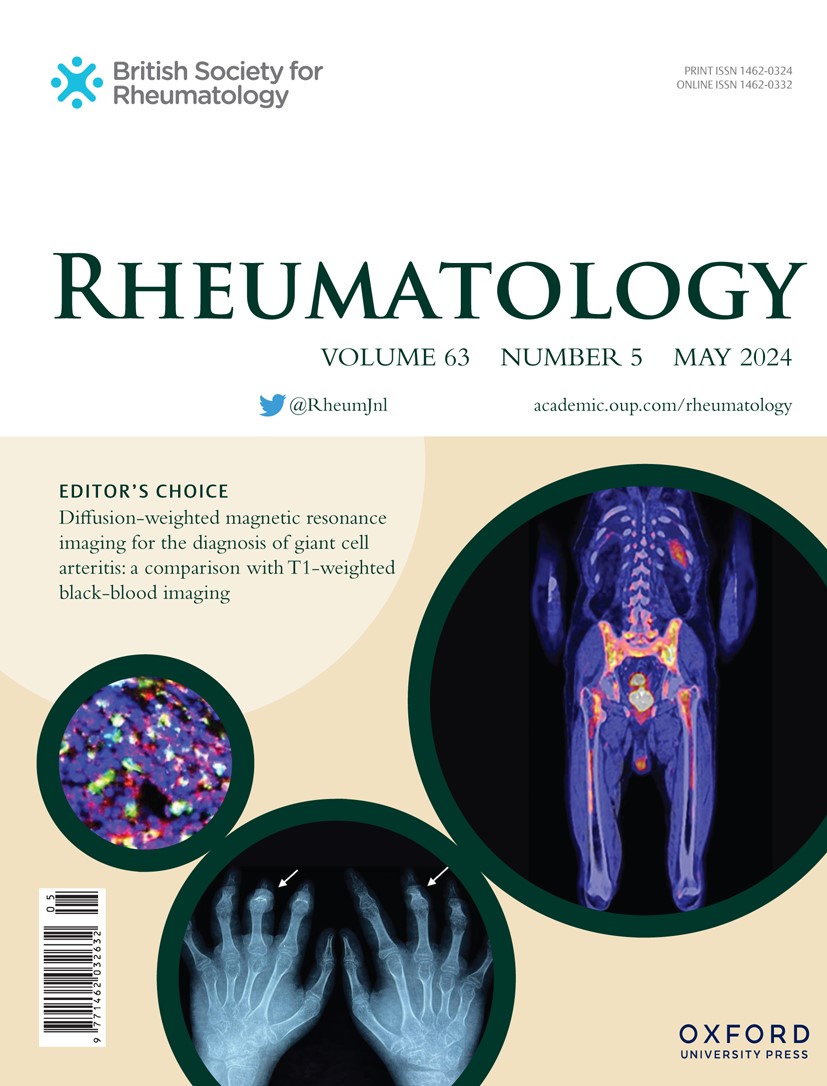The Fibrosis-4 Index (FIB-4) correlates with cardiovascular risk and insulin resistance in patients with rheumatoid arthritis.
IF 4.7
2区 医学
Q1 RHEUMATOLOGY
引用次数: 0
Abstract
OBJECTIVES The Fibrosis-4 index (FIB-4), a non-invasive tool for assessing liver fibrosis, has also been linked to cardiovascular (CV) risk in the general population. This connection is due to the association of chronic liver diseases, particularly fibrosis or non-alcoholic fatty liver disease, with systemic inflammation, metabolic syndrome, and atherosclerosis. In this study, we aimed to calculate the FIB-4 index in patients with rheumatoid arthritis (RA), a condition associated with increased CV disease risk. We then examined its association with disease characteristics and CV comorbidities, including lipid profile, subclinical carotid atherosclerosis, and insulin resistance indices. METHODS A total of 465 RA patients were recruited in this cross-sectional study. They underwent comprehensive evaluations, including disease-related features, complete lipid profile, anthropometric measurements, insulin resistance indices (using HOMA), metabolic syndrome criteria, and carotid ultrasound for intima-media thickness and carotid plaque detection. FIB-4 was calculated and categorized into low (<1.45), indeterminate (1.45-3.25) and high risk (>3.25) for fibrosis. A multivariable linear regression analysis was performed to examine the associations between the disease characteristics and FIB-4. RESULTS Twenty percent of RA patients had a FIB-4 score indicating indeterminate or high risk for hepatic fibrosis. FIB-4 was significantly associated with higher values of the cardiovascular risk calculator SCORE2 but not with carotid atherosclerosis. It was also significantly related to insulin resistance and metabolic syndrome. However, after multivariable analysis, FIB-4 did not correlate with RA disease characteristics, including disease activity. CONCLUSION Up to 20% of RA patients show an abnormal FIB-4 index, which correlates with cardiovascular risk and insulin resistance.类风湿关节炎患者的纤维化-4指数(FIB-4)与心血管风险和胰岛素抵抗相关。
纤维化-4指数(FIB-4)是一种评估肝纤维化的非侵入性工具,在普通人群中也与心血管(CV)风险相关。这种联系是由于慢性肝病,特别是纤维化或非酒精性脂肪肝,与全身性炎症、代谢综合征和动脉粥样硬化有关。在这项研究中,我们旨在计算类风湿关节炎(RA)患者的FIB-4指数,这是一种与CV疾病风险增加相关的疾病。然后,我们研究了其与疾病特征和心血管合并症的关系,包括血脂、亚临床颈动脉粥样硬化和胰岛素抵抗指数。方法本横断面研究共纳入465例RA患者。他们接受了全面的评估,包括疾病相关特征、完整的脂质谱、人体测量、胰岛素抵抗指数(使用HOMA)、代谢综合征标准、颈动脉内膜-中膜厚度超声和颈动脉斑块检测。计算FIB-4并将其归类为低(3.25)。进行多变量线性回归分析以检查疾病特征与FIB-4之间的关系。结果:20%的RA患者FIB-4评分表明肝纤维化风险不确定或较高。FIB-4与较高的心血管风险计算器SCORE2值显著相关,但与颈动脉粥样硬化无关。与胰岛素抵抗和代谢综合征也有显著相关性。然而,在多变量分析后,FIB-4与RA疾病特征(包括疾病活动性)没有相关性。结论高达20%的RA患者FIB-4指数异常,与心血管风险和胰岛素抵抗相关。
本文章由计算机程序翻译,如有差异,请以英文原文为准。
求助全文
约1分钟内获得全文
求助全文
来源期刊

Rheumatology
医学-风湿病学
CiteScore
9.40
自引率
7.30%
发文量
1091
审稿时长
2 months
期刊介绍:
Rheumatology strives to support research and discovery by publishing the highest quality original scientific papers with a focus on basic, clinical and translational research. The journal’s subject areas cover a wide range of paediatric and adult rheumatological conditions from an international perspective. It is an official journal of the British Society for Rheumatology, published by Oxford University Press.
Rheumatology publishes original articles, reviews, editorials, guidelines, concise reports, meta-analyses, original case reports, clinical vignettes, letters and matters arising from published material. The journal takes pride in serving the global rheumatology community, with a focus on high societal impact in the form of podcasts, videos and extended social media presence, and utilizing metrics such as Altmetric. Keep up to date by following the journal on Twitter @RheumJnl.
 求助内容:
求助内容: 应助结果提醒方式:
应助结果提醒方式:


